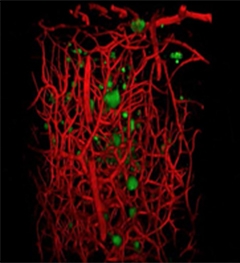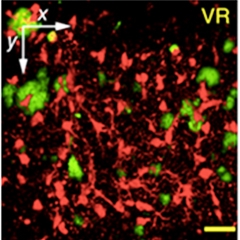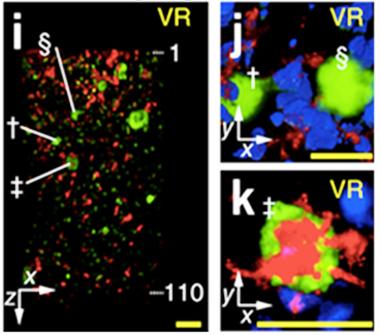With ScaleS, You Can See Through the Brain to Behold Synapses
Quick Links
Optical clearing renders tissue transparent, exposing cellular components to the gaze of light microscopists. Unfortunately, the mishmash of reagents used to clarify the tissue can also warp its shape or alter the chemistry of the molecules that remain. Now, in the September 14 Nature Neuroscience, researchers led by Takaomi Saido and Atsushi Miyawaki at RIKEN in Saitama, Japan, describe a better way. ScaleS clarified brain hemispheres while preserving their fine structure down to the level of synapses. Fluorescent antibodies and small molecules uniformly penetrated the clarified tissue, yielding strong signals throughout. The method allowed researchers to spy three-dimensional interactions between amyloid plaques, blood vessels, and microglia in the brains of aged mouse models of Alzheimer’s disease, and, most strikingly, in postmortem brains from people with the disease.

Tangled Web.
In this still from the movie below, blood vessels (red) criss-cross a ScaleS-cleared cortical cube from an AD mouse. Plaques (green) hang out nearby. [Courtesy of Hama et al., Nature Neuroscience.]
The ability to clarify and fluorescently probe postmortem brain samples from older people is a major advance, commented Brian Bacskai of Massachusetts General Hospital in Boston, who was not involved in the study. Because aging tends to make tissue more fragile, researchers have used clearing methods primarily to analyze tissue from younger people. However, ScaleS was gentle enough to probe aging tissue without destroying its integrity. “The implications of this are huge if the technique works for other researchers as well as it worked for them,” Bacskai said.
The concept of optical clearing has been around for decades, but recent years have seen an explosion of new techniques as imaging methods have improved. Many of the techniques rely on high levels of detergents to destroy the lipids that make tissue opaque. One method, called CLARITY, improved upon previous clearance methods, and employed electrophoresis to pump the clearing solution into the tissue (see Apr 2013 news). PACT (or passive CLARITY) ditched the electrophoresis due to its finicky performance and occasional damage to tissue from overheating. However, PACT used a high concentration of detergent—8 percent SDS—and did not increase brain permeability enough to allow penetration by full-size fluorescently labeled antibodies (see Jul 2014 news). Such detergents can compromise membrane integrity and dampen signals emanating from fluorescent molecules expressed by or added to the tissue, Saido said.
First author Hiroshi Hama and colleagues wanted to develop a clearing technique that preserved cellular structure and the strength of fluorescent signals throughout the clarified tissue. They built upon a previous technique, called ScaleA2, which used a urea-based solvent to render a mouse brain transparent over a two-week period (see Hama et al., 2011). ScaleA2 cleared the tissue slowly but caused it to swell and become fragile. The researchers added sorbitol, a sugar alcohol that also has clearing properties, to their urea solution. Because sorbitol dehydrates, and thus shrinks, tissue, while urea does the opposite, the researchers adjusted their concentrations until they had a potion that cleared a rodent brain without changing its size. The researchers opted for a very low concentration of detergent, predicting that this would safeguard fluorescent signals. They dubbed this new sorbitol-based method ScaleS.
Hama and colleagues used mice expressing yellow fluorescent protein (YFP) to evaluate ScaleS. Compared with brain hemispheres treated with 3DISCO, SeeDB, CUBIC, or PACT clearing methods, ScaleS-treated tissue struck the optimal balance between transparency and fluorescence intensity, wrote the authors. For example, ScaleS-treated samples became just as transparent as PACT preparations, but the intensity of YFP fluorescence was double that of tissue clarified by the older method.
The researchers used transmission electron microscopy (TEM) to determine how ScaleS treatment preserved cellular structures. To do this, they placed clarified tissue back into saline solution (a state they referred to as “deScaled”), fixed it, and cut it into ultrathin slices. TEM revealed distinct post-synaptic densities (PSDs), as well as intact membranes enveloping both pre- and post-synaptic terminals. In contrast, other clearance methods severely disrupted the synaptic membranes of PSDs.
Next, the researchers used confocal microscopy to find that fluorescently labeled antibodies as well as fluorescent chemical compounds could evenly penetrate an entire ScaleS-treated mouse brain hemisphere, which measures roughly 6x4x4 mm. Saido told Alzforum that it is still unclear how ScaleS allows proteins to penetrate so well, but that subtle changes in membrane structure may allow molecules to flood the tissue.
The researchers took advantage of this permeability to stain both amyloid plaques and blood vessels in the brains of 20-month-old APPNL-F knock-in mice, which express normal levels of human APP containing AD-associated mutations. The researchers perfused the mice with fluorescently labeled lectin to stain blood vessels, then removed and clarified the left brain hemisphere with ScaleS. They then stained the hemisphere with fluorescently tagged antibody against Aβ, and analyzed a 600 μm cube of cortical tissue with selective plane illumination microscopy. Also known as optical slicing, SPIM images sequential sheets of tissue from a larger sample. When Hama stacked the images, he saw a thicket of blood vessels adorned with Aβ plaques. Almost all the plaques were either touching the vessels or posted right next to them (see movie below).
Did these plaques affect nearby synapses? To find out, the researchers stained ScaleS-clarified brain hemispheres from 24-month-old APPNL-F mice with the 6E10 anti-Aβ antibody, fixed and sliced the tissue into ultrafine sections, and visualized plaques with immunoelectron microscopy. They found signs of neuritis—neuroinflammation and synaptic damage—in neurons associated with plaques, but not in other neurons. The findings suggested that direct contact with plaques triggered neuronal damage.

Three-Dimensional Connections.
Researchers looked at ScaleS-cleared sections of mouse brain to measure the distance between microglia (red) and plaques (green) in all three dimensions. [Courtesy of Hama et al., Nature Neuroscience, 2015.]
Next, Hama and colleagues set their sights on the relationship between amyloid plaques and microglia. Researchers are still trying to understand whether these brain-resident macrophages do more harm or good in AD. SPIM imaging on ScaleS-clarified brain tissue revealed plaques and microglia in three dimensions. One tissue block from a 20-month-old APPNL-F mouse contained 137 microglia and 39 Aβ plaques. Twenty-six of the plaques sat in isolation while the remainder comingled with amoeboid, active microglia. In some instances several activated microglia clustered around a single plaque. Interestingly, when the researchers performed the same analysis on younger, 10-month-old mice, they found that microglia associated with nearly every single plaque in a given tissue block. They hypothesized that microglia mount a neuroinflammatory response against plaques early in the disease process, which wanes as disease progresses.
Would this hot-cold relationship between plaques and microglia manifest in humans as well? The researchers used ScaleS to clarify postmortem brain samples from nine AD patients, then stained them with antibodies against Aβ and the microglial marker Iba1. Some patients harbored dense-core plaques, while others had primarily diffuse Aβ deposits. The researchers noted that the diffuse plaques are often not properly identified using two-dimensional techniques, because their vague boundaries extend beyond the image plane. Using the three-dimensional imaging facilitated by ScaleS clearance, the researchers could visualize the entirety of each diffuse plaque and identify it as such. Interestingly, they found that for the most part, microglia congregated around diffuse plaques but had no interest in dense-core plaques, which sat isolated and untouched by the macrophages. The researchers rarely noted both diffuse and dense plaques in the same sample. They hypothesized that the former, which may spew out toxic oligomers and attract microglia, are the precursors to dense-core plaques, which no longer trigger inflammatory responses.

Hard Core Imaging.
Cleared brain tissue from an 84-year-old woman with AD reveals dense-core plaques (green) and microglia (red). [Courtesy of Hama et al., Nature Neuroscience, 2015.]
“In tissue clearing, there is a fine balance between maintaining sample integrity and having robust optical and macromolecule access throughout intact thick volumes. Trade-offs are made depending on the final scope of the work,” commented Viviana Gradinaru of Caltech in Pasadena, who was not involved in the study but helped pioneer the CLARITY and PACT techniques. “Methods that retain fine structure for electron microscopy analysis, as Hama et al. showed, will be important for projects that need detailed views of synapses.”
In addition to its usefulness in imaging human samples, ScaleS could also come in handy for three-dimensional mapping of network connectivity between different brain regions in mice, Bacskai commented. This a priority for the NIH Brain Initiative.
Saido added that his lab wants to use ScaleS to understand which forms of Aβ are targeted by various therapeutic antibodies. Currently, it is difficult to discern whether antibodies aimed at Aβ primarily attack free-ranging Aβ or go after plaques. Also, whether the antibodies prefer diffuse or dense-core plaques, or parenchymal versus blood vessel-associated plaques, and what role microglia play in the plaque clearance process, are all issues that could be explored using ScaleS, he said. Researchers would have the option of zooming down to synapses to assess how a treatment affects neuronal function.—Jessica Shugart
Media
References
News Citations
Research Models Citations
Paper Citations
- Hama H, Kurokawa H, Kawano H, Ando R, Shimogori T, Noda H, Fukami K, Sakaue-Sawano A, Miyawaki A. Scale: a chemical approach for fluorescence imaging and reconstruction of transparent mouse brain. Nat Neurosci. 2011 Nov;14(11):1481-8. PubMed.
Further Reading
Papers
- Richardson DS, Lichtman JW. Clarifying Tissue Clearing. Cell. 2015 Jul 16;162(2):246-57. PubMed.
Primary Papers
- Hama H, Hioki H, Namiki K, Hoshida T, Kurokawa H, Ishidate F, Kaneko T, Akagi T, Saito T, Saido T, Miyawaki A. ScaleS: an optical clearing palette for biological imaging. Nat Neurosci. 2015 Oct;18(10):1518-29. Epub 2015 Sep 14 PubMed.
Annotate
To make an annotation you must Login or Register.

Comments
No Available Comments
Make a Comment
To make a comment you must login or register.